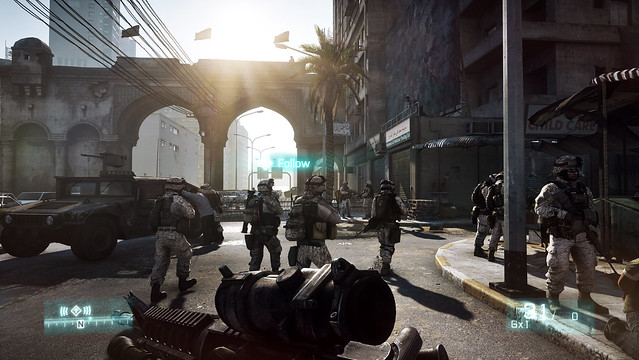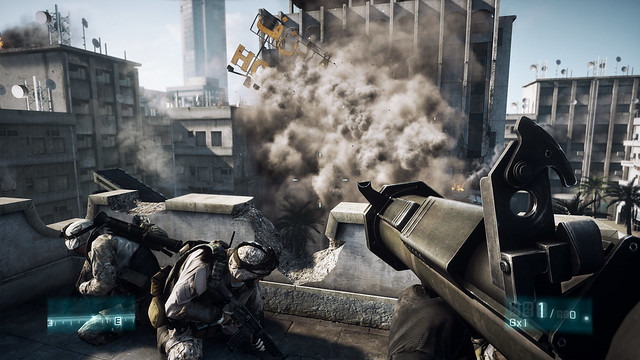War has changed. And fortunately, it’s changed for the better. Not long ago, Jeff and I went hands-on with an early, pre-alpha PS3 build of Battlefield 3’s multiplayer mode. Building on the positive buzz behind the smash hit Battlefield Bad Company 2, developer DICE is crafting a muscular follow-up that leverages new animation and rendering tech, revamped online features, and a rough-and-tumble feel to create a new breed of military shooter.
During the multiplayer battle, Jeff and I found ourselves on opposing sides (my side won, naturally). Following our all-too-brief hands-on session, Jeff and I compared notes on the finer points of Battlefield 3’s multiplayer mode.

Sid Shuman: With Call of Duty’s twitchier play style becoming the industry norm for many multiplayer military shooters, I was most curious to see how Battlefield 3′s multiplayer would stake out its own territory. I was pleased to find a highly accessible game that remains faithful to Battlefield’s realistic roots while evolving the look, feel, and tactics. This is a shooter that has learned several important lessons from Call of Duty — primarily in the realm of accessibility — but stands firmly on its own boot-clad feet.
Jeff Rubenstein: I know you’re more of a fan of team-based multiplayer modes, so you must’ve enjoyed the Rush mode we sampled. A Battlefield staple, teams are divided into offense and defense, with the attackers attempting to take objectives (or blow them up, as it were), pushing the defenders back. I enjoy these matches because it’s not about who gets the most kills, it’s about who achieves the most objectives. The selfish generally lose.
Naturally, we were on opposite teams.
Sid: Indeed. The multiplayer map we played on, Operation Metro, was focused on straightforward infantry play and made an ideal testbed for Rush’s symmetrical combat. Diving into the first match, I was immediately drawn to Battlefield 3’s map design. On the Operation Metro map, rolling hills gave way to clumps of thick vegetation interspersed with armored barricades and rock formations, giving a more organic, liberating feel to movement and fighting. This isn’t a shooter where you’ll sprint down the same dusty hallways and snipe out of the same dusty windows again and again ad nauseum. Battlefield 3’s porous but open map design forces you to constantly scan your surroundings for stealthy approaches. Combined with a devastatingly realistic damage model and a short-but-nerve-wracking respawn timer, I found myself playing far more carefully than I’m accustomed to in multiplayer shooters — I’d pop off a few shots, scramble for safety, lay low, then work to flank any nearby opponents. The experience was more harrowing than some survival-horror games I’ve played, and forced me to lay down suppressive fire and breathlessly belly-crawl to avoid being gunned down. And it worked, for more than 10 straight kills, until somebody tapped me with a high-powered sniper rifle and the lights went out for good.

Jeff: You know, due to my squad’s inability to dislodge you defenders from your perch in a gazebo, we weren’t able to push you back, and hence we weren’t able to see the full range of the map, which includes an underground subway depot. Interestingly, the Operation Metro map is based on an actual Parisian park – DICE’s Owen Johnson told me that some French fellas that tried out the demo earlier said it was quite accurate, although the actual Metro station is a bit more, shall we say, worn-in in real life.
Sid: You know, they say the Swedes are a very meticulous people. Beyond the map’s sprawling size and alleged geographic accuracy, I was also struck by the new ways you can interact with the environment. Battlefield 3 has an immersive physicality I don’t often see in shooters — it intermittently reminded me of Mirror’s Edge, incidentally also developed by DICE. I liked how, when I mantled over a low barricade, my character scissor-kicked his legs over the obstruction rather than weightlessly hop over it as in many other shooters. It feels jarring and rough-and-tumble, but convincing in a way that connected me with the environment. As an example, I frequently found myself sprinting away from danger and then diving to avoid incoming fire, making my character slide heavily through the grass in a way that made me wince. In fact, I did quite a bit of the latter due to some sharpshooters on your team. Hey, you were playing as a sniper, weren’t you?
Jeff: Ugh, that was *not* on purpose. In my rush to jump into the game as quickly as possible, I started hammering on the X button, and I was dropped into the match in the Recon class, which you might know as a “sniper.” I figured I might not last too long (I didn’t!), so I decided to explore the ways the Recon class has evolved since BF:BC2. In a notable change, every character class can now dip into a full prone stance. To help balance a sniper’s new, lower profile, DICE is adding a bit of weapon glint to help betray a sniper’s position when he zeros in on a target for too long. I picked a safe-looking spot, laid down, and drew a bead on an enemy. What I noticed immediately wasn’t that I missed – I expected that. It was the incredible crack of the rifle’s discharge. The report sounded LOUD and DANGEROUS. In fact, throughout the rest of the session, I noticed that the guns sounded more fearsome and deadly than the arms I’ve used in other games recently. If nothing else, Battlefield 3 brings definite improvements to its treatment of audio. Which class were you using?

Sid: I mostly stuck with the Assault class, a versatile, combat-ready role that shares abilities of a field medic, including a portable defibrillator that resurrects fallen allies and medkits that you can use to heal wounded teammates. I also tinkered with the Support class that boasts a bodacious light machinegun and a pocketfull of ammo. Interestingly, the Support class can deploy a portable bipod on any solid surface (a barricade or the ground) in order to boost range and accuracy, effectively creating a high-powered turret at will.
On that note, I was impressed to see that, unlike most shooters, Battlefield 3 emphasizes laying down suppressive fire — a key tactic in controlling and winning a real-life firefight. You’ll actually gain XP when you pin enemies behind cover. Better yet, you’ll also blur the vision of any enemies you suppress, putting them at a disadvantage. This is a perfect match for the Support class, with its high-capacity ammo clips.
Jeff: I do like the idea of folding in the typical medic class with the Assault troops – both those types are usually at the front line anyways. I typically lean on the Engineer class, as I enjoy both the destruction and repairing of tanks. Johnson noted that “Engineer has changed the least.” I’m fine with that. Did you happen to land a melee kill? They’ve added an interesting collection aspect via customizable dog tags, allowing you to form a collection of your most intimate finishers. I’m sure we’ll hear and see more of that feature down the line.
***
Well, that’s all the commentary we could squeeze out of a 10-minute multiplayer match, but the taste was enough to have us salivating for a larger bite of Battlefield 3. You can be sure we’ll keep you updated here on the PlayStation Blog as we get further samplings between now and the game’s October 25th release date. Don’t forget, Battlefield 1943 is included on the Blu-ray disc as a free bonus, only for PS3.





























